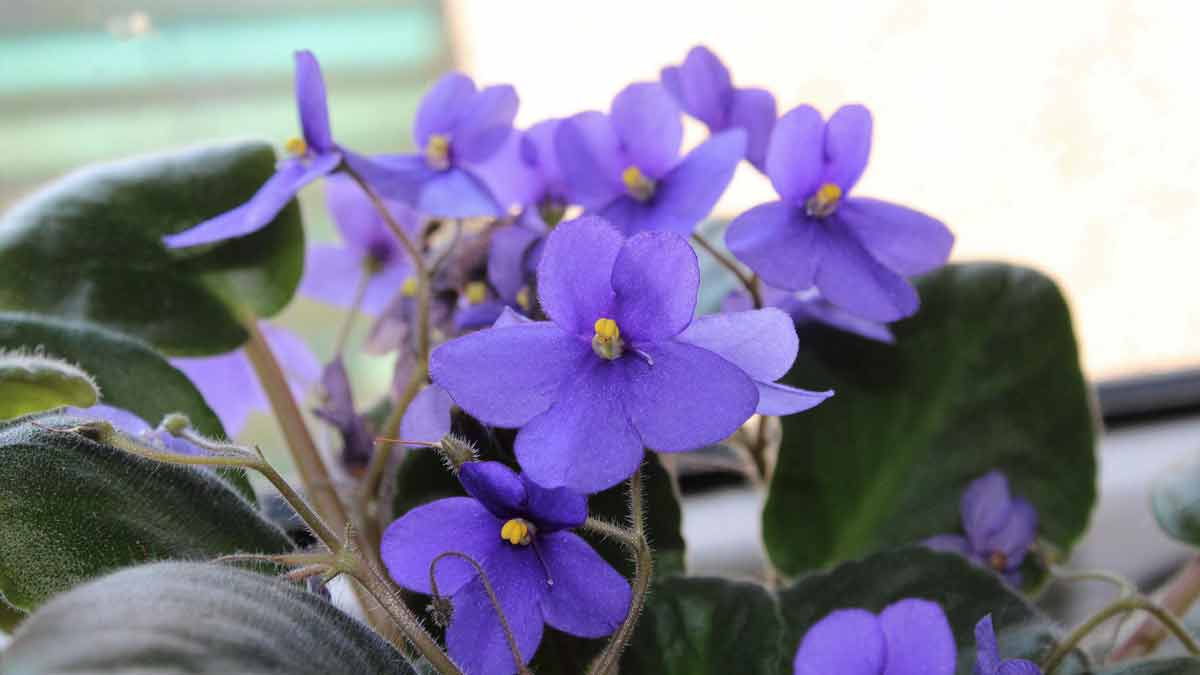African violets (Saintpaulia) are one of the most popular houseplants. They are relatively easy to care for, and they bloom frequently.
However, they are susceptible to several problems, including pests, diseases, and environmental stressors. One of the most common problems is leggy growth.
Leggy African violets typically have long, spindly stems with few leaves. The flowers may be small and sparse, or they may not bloom at all.
There are several reasons why African violets may become leggy. The most common cause is insufficient light. African violets need bright, indirect light to thrive. They will stretch out towards the nearest light source if they don’t get enough sunlight.
In this article, you’ll find everything you need to know about how to fix a leggy African violet plant.
What Causes an African Violet To Become Leggy
There are several reasons why African violets may become leggy.
The most common reasons are:
Not Enough Light
African violets need bright, indirect light to thrive. They will stretch out towards the nearest light source if they don’t get enough sunlight.
This is called etiolation, and it results in leggy growth.
African violets need at least 8 hours of bright, indirect light per day, they will do best with 10-12 hours.
Although African violets can tolerate some direct sunlight, it is best to avoid it. The leaves of African violets are delicate, and they can sunburn easily.
Light is essential for plants because it is used in photosynthesis. Photosynthesis is the process that plants use to convert sunlight into energy.
If a plant doesn’t get enough light, it will not be able to produce enough energy to support its growth. This can result in leggy growth and other problems, such as yellow leaves and stunted growth.
Too Much Nitrogen
Nitrogen is an essential nutrient for plants. It is used in the process of photosynthesis, and it is also a key component of chlorophyll.
Chlorophyll is what gives plants their green color, and it is essential for photosynthesis. Nitrogen is also used to produce proteins, enzymes, and cell walls.
Plants need nitrogen for healthy growth, but too much nitrogen can be problematic. Nitrogen is a mobile nutrient, which means that it can move quickly through the plant.
If too much nitrogen is in the soil, it will be absorbed by the plant and accumulate in the leaves. This can cause the leaves to become yellow and may eventually kill the plant.
Too much nitrogen can also cause leggy growth, as the plant will grow too fast and be unable to support its weight.
Fertilizers are typically high in nitrogen. If you fertilize your African violets too frequently or use a fertilizer that is too high in nitrogen, you may end up with leggy plants.
Age Issues
As African violets age, they will naturally become leggier. This is because the lower leaves will die off, and the stems will become longer.
As the plant ages, the lower leaves will be yellow and eventually fall off. This is normal, and it is not a cause for concern.
Once the lower leaves have fallen off, the plant will be leggier. However, this is not a reason to throw away your African violet.
An older, leggy African violet can still be healthy and bloom frequently.
How To Tell If Your African Violet Is Leggy
It’s not always easy to tell if your African violet is leggy.
There are a few key signs that you can look for, including:
The African Violet Has Long, Spindly Stems
If the stems of your African violet are long and spindly, the plant is likely leggy. Leggy plants have stems that are significantly longer than they should be.
Healthy African violet plants should have short, sturdy stems. If the stem is long and spindly, it is a sign that the plant is not getting enough light.
When African violets grow in low light conditions, they stretch out towards the nearest light source. This stretching causes the stems to become long and thin.
It also results in weaker stems that are more likely to break.
The African Violet Has Few and Small Leaves
If your African violet has few leaves, it is another sign that the plant is leggy. Leggy plants often have fewer leaves than healthy plants because they cannot produce enough chlorophyll.
Chlorophyll is essential for photosynthesis; without it, the plant will not be able to produce enough food for itself. This can cause the plant to have fewer leaves, as well as smaller leaves.
The African Violet Flowers Are Small and Sparse
If the flowers on your African violet are small and sparse, it is another sign that the plant is leggy. Leggy plants often have fewer and smaller flowers because they do not have enough energy to produce them.
As a result, the plant will often bloom less frequently, or it may not bloom at all.
The African Violet Is Not Growing
If your African violet is not growing, the plant is likely leggy.
When plants are leggy, they often stop growing. This is because they do not have enough energy to produce new growth.
As a result, the plant will often stay the same size for long periods.
The African Violet Has Yellow Leaves
If your African violet has yellow leaves, it is another sign that the plant is leggy.
Nitrogen is a critical component of chlorophyll; too much nitrogen can cause the leaves to turn yellow.
When the leaves turn yellow, it is also a sign that the plant is not getting enough light.
The African Violet Leaves Are Drooping
If the African violet leaves are drooping, it is another sign that the plant is leggy.
Leggy plants often have weak stems that cannot support the leaves’ weight. As a result, the leaves will often droop down.
The African Violet Looks Weak and Unhealthy
The plant is likely leggy if your African violet looks weak and unhealthy. Leggy plants are often less vigorous and less healthy than plants that are not leggy.
Their leaves are often smaller and may have fewer leaves than healthy plants. In addition, their flowers are often small and sparse.
How To Fix A Leggy African Violet
Growing African violet plants can be a challenge, but there are a few things that you can do to fix a leggy African violet.
Here are a few tips:
1. Move The Plant To A Bright Location
If your African violet is leggy, the first thing that you should do is move the plant to a sunny location. Low light conditions often cause leggy plants, so moving the plant to a brighter location will often help.
African violets need at least 8 hours of light per day, so try to find a spot with plenty of sunlight.
An east-facing window is often a good option since it will provide bright, indirect light. A south-facing window will also work well.
You can also use grow lights if you cannot find a spot that gets enough light. These special lights mimic the sunlight and can help your plant grow.
2. Prune The Plant
You can also try pruning the plant if your African violet is leggy.
Pruning will help to encourage the plant to produce new growth, and it can also help to make the plant more compact.
How To Prune Leggy African Violets
- Remove any dead or dying leaves
- Remove any leaves that are yellow or discolored
- Remove any leaves that are significantly smaller than the other leaves
- Trim off any long, spindly stems
You can also try pinching back the plant. Pinching back is similar to pruning but involves removing the tips of the stems.
This will help to encourage the plant to produce new growth.
3. Stop Fertilizing The Plant
If you are fertilizing your African violet, stop. Leggy plants are often caused by too much nitrogen, so stopping fertilizer will often help.
It is also a good idea to flush the soil with water. This will help to remove any excess fertilizer that may be in the soil.
When you start fertilizing again, use a fertilizer low in nitrogen.
4. Repot The Plant
You may also need to repot the plant if your African violet is leggy. Leggy plants often become rootbound, which means their roots grow too tightly together.
This can prevent the plant from getting the nutrients that it needs, and it can also cause the plant to become leggy.
How to Repot a Leggy African Violet
To repot your leggy African violet:
- Remove the plant from its current pot
- Trim off any roots that are damaged or dead
- Place the plant in a new pot that is slightly larger than the old one
- Fill the pot with fresh potting soil
- Don’t water the plant for a few days to allow the roots to adjust to their new environment
How To Prevent Leggy African Violets
The best way to prevent leggy African violets is to provide the plant with the proper care.
Here are a few tips:
1. Provide Bright Light
African violets need at least 8 hours of light daily and prefer bright, indirect light. If you can provide 12 hours of light, that’s even better.
But be careful not to place your African violet in direct sunlight, as this can scorch the leaves.
An east-facing window is a good option, as is a south-facing window, if you can filter the light with a sheer curtain.
2. Turn the Plant Regularly
African violets grow best when they’re turned so that all sides of the plant get an equal amount of light.
So, every few days, rotate your plant by a quarter turn. This will help it grow evenly and prevent leggy growth.
3. Trim the Plant Regularly
To encourage full, bushy growth, trim your African violet regularly.
Cut off any leggy stems and any yellow or brown leaves. Trimming also helps to prevent the plant from getting too big for its pot.
4. Fertilize Properly
African violets must be fertilized regularly to stay healthy and prevent leggy growth.
Use a fertilizer made specifically for African violets, and follow the directions on the package.
Avoid using high nitrogen fertilizers, as these can cause leggy growth.
A good rule of thumb is fertilizing every two weeks during the growing season. During the winter, stop fertilizing or cut back to once a month.
5. Repot When Needed
African violets need to be repotted every year or two. This gives them fresh potting soil and room to grow.
When repotting, use a pot slightly larger than the current one. And be sure to use potting soil made specifically for African violets.
Final Thoughts
An African violet is a great indoor plant because it doesn’t require a lot of maintenance and can prosper in many different environments.
However, even the hardiest of plants can have problems from time to time.
If you notice that your African violet has leggy growth, don’t fret. With some basic care, you can return your plant to its bushy self in no time.







